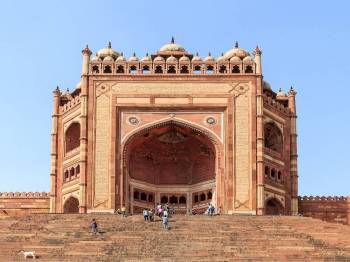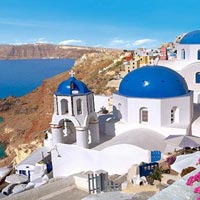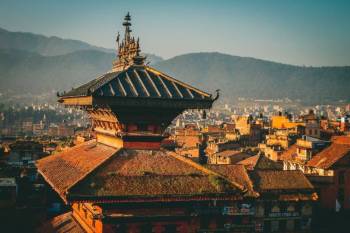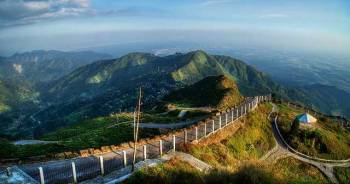6 Nights / 7 Days

Monument fee and special arrangement fee, accommodation cost.
Opon arrival at Bagdogra Airport, you will be received and undertake a three hours drive to Darjeeling along verdant hillsides carpeted with well-maintained tea bushes of the tea gardens. Darjeeling derived its present name from the local Tibetan name Dorjee – Ling, which means Place (Ling) of the Thunderbolt (Dorjee). The place conjures visions of serenity, of vibrant green hills steeped in splendor, a land of breathtaking beauty crowned by the majestic Himalayas. This heavenly retreat is bathed in hues of every shade. The flaming red rhododendrons, the sparkling white magnolias, the miles of undulating hillsides covered with emerald green tea bushes, the exotic forests of silver fir - all under the blanket of a brilliant azure sky dappled with specks of clouds, compellingly confirms Darjeeling as the QUEEN OF HILL STATIONS. Darjeeling beckons thousands today for a leisurely respite from the bustle of the madding crowd. The traveler - whether a tourist or a trekker, an ornithologist or a photographer, a botanist or an artist - will find in Darjeeling an experience which will remain etched in ones memory forever.
Overnight stay at your hotel in Darjeeling.
Today you have a delightful day in Darjeeling. You will have the opportunity to ride the Toy Train. It was a tiny four-wheeled trolley when it first rolled out. People, sacks of tea, bags of potatoes, wool from Tibet, Kalimpong oranges, jute and paddy stacks and more used to find space under its canvas roof and two quaint wooden benches.
It's been over a century since then and the Darjeeling Himalayan Railway - popularly known as the Darjeeling Toy Train - no longer ferries sacks of grain. Instead, it takes starry-eyed couples on their honeymoon, college student on their first excursion, tourists enjoying a luxurious vacation and holidaymakers of every persuasion up and down the slopes of Bengal's hills. On this railway track one cannot help marvel the engineering feat called Batasia Loop. It was constructed with the purpose of allowing the train to take the sharp rise in altitude between Darjeeling and Ghoom (2,400 m / 8,000 ft) with ease. It is quite an interesting experience to watch the toy train negotiate the loop through the well-manicured garden of flowers with the Khangchen Dzonga (the third highest mountain in the world) and the Darjeeling town in the background.
In the afternoon you visit Happy Valley Tea Estate. Of about seventy tea gardens in this hilly region, this is one of the nearest, about 3 km from the town. Here one can see the processing of the world famous Darjeeling tea and also indulge in a tea tasting session. While in Darjeeling one must take a relaxed stroll on the Chowrasta under the watchful gaze of the mighty Khangchen Dzonga range in the east and the rolling hills of Sikkim in the north to enjoy the flavor of this picturesque hill station. The exquisitively designed wooden shops on the Mall were constructed more than a century ago and still hark back to the British era. The Chowrasta has many curio shops that sell thankas (scrolls with religious paintings), fabrics, woodcarvings, carpets and many other local products. Your stroll takes you below the Saint Andrews Church that was built in 1843 and reconstructed in 1882. Adjacent to the church is the Gymkhana Club that was established in 1915. Spectacular views of the well-manicured tea gardens and various towns in South and West Sikkim can be obtained along the way. Far down below the Ranjit River can be seen snaking its way through the mountains.
Overnight stay at the hotel.
A drive along the Tista Valley takes you to the Sikkim border at Melli and then you travel through the Rangit Valley up to Pemayanste. From here one can view Mt. Khangchen Dzonga (8,588 m / 25,168 ft), Pandim (6,693 m / 21,953 ft), Siniolchu (6,889 m / 22,597 ft) and other ranges. Situated on a hillock is Pemayanste Monastery, belonging to the Nyingmapa sect. This Monastery is the head of all other monasteries of this sect in Sikkim. Your journey to Pemayangtse takes you past Rabdanste, which was the second capital of Sikkim and was established in the late 17th century by the second Chogyal of Sikkim. It was abandoned towards the end of the 18th century because of the threat posed by the Nepalis. On arrival check in to your accommodation for overnight stay.
In the afternoon enjoy a guided tour of the premier monastery of Pemayanste (Perfect Sublime Lotus). Latsun Chembo first built it as a small temple in the late 17th century. Later Jigme Pawo, who was the third reincarnate of Latsun Chembo, extended and rebuilt the structure in the form of a big monastery. The monastery contains numerous antique idols and objects of worship, most of which are priceless because of their antiquity. On the top floor is a seven tiered painted wooden sculpture portraying the Mahaguru's Heavenly Palace 'Sangthokpalri' which was completed in a span of five years, single handily by the late Dungzin Rinpoche. Annual Chaam dance is held on the 28th and 29th day of the 12th month of the Tibetan calendar, normally corresponding to the month of February.
A 2 km walk from the main road near Pemayanste Monastery through a thick forest will take you to Rabdanste Palace. The Palace is in ruins, however, the chortens around it have withstood the elements of nature. The ruins are now being preserved by the Archaeological Survey of India and have been declared a monument.
Overnight stay at the hotel.
Today you drive to Gangtok, the "Lofty Hill", which is the capital of Sikkim. The Ranipool River flows to its west. Gangtok has a very spectacular setting and offers excellent views of the entire Khangchen Dzonga range from various points in its vicinity. It is a city, which, till one sees it, one would believe exists only in picture-story books. In the mystery-laden mists prayer flags whip the breeze and wheels spin in the hands of lamas mumbling invocations to God. In the distance are the snows, on the streets amidst brightly painted pagoda roofed houses, lined with friendly smiling people are silver, silk, spice and jewellery to gladden a maiden's heart. On arrival at Gangtok you will be assisted to check into your hotel.
In the afternoon visit Enchey Monastery, Lama Druptob Karpo is supposed to have built a small hermitage at this spot after he flew here from Maenam Hill more than two hundred years ago. During the reign of Sidkeong Tulku, a monastery was built here in 1901 in the form of a Chinese Pagoda. The monastery follows the Nyingma Order and the main puja and dances are held here on the 18th and 19th of the twelfth month of the Tibetan calendar, which normally corresponds to the month of December. You can also spend a delightful evening strolling around downtown to take in the ambience of this mystic hill town. Many a shop in the bustling market place that is in the heart of the town will catch your fancy with the curios and local handicraft on display.
Overnight stay at the hotel.
In the morning visit Rumtek Monastery, which is perched on a hilltop facing the city of Gangtok. The original Monastery was built in 1730 by the ninth Karmapa but was destroyed due to a fire and His Holiness, the sixteenth Karmapa in 1960, then constructed the present one. It is certainly the largest monastery in Sikkim and is a fine example of Tibetan architecture. The prayer hall in the main monastery is intricately decorated with statues, wall paintings, thangkas and tubular silk banners. A flight of stairs from just outside the Main Monastery complex takes you to the Nalanda Institute for Higher Buddhist Studies. 15 minutes walk downhill from the Main Monastery takes one to the Old Rumtek Monastery.
The main puja or dances of Rumtek also called the Tse-Chu Chaama are held on the 10th day of the 5th month of the Tibetan calendar around June. Dances called the Kagyat are also held on the 28th and 29th of the tenth month of the Tibetan calendar in the Old Rumtek Monastery.
The other places of interest during your day in Gangtok are - Government Institute of Cottage Industries: This centre offers you the opportunity to observe the local artisans at work and their skills being imparted to young boys and girls. If you want to take back souvenirs, the institute's salesroom is well stocked with local handicraft and handloom products. Do-Drul Chorten: One of the most important Stupas of Sikkim built by the late Venerable Trulsi Rimpoche in 1945-46, it contains a mandala of Dorji-Phurpa, holy texts, mantras and is encircled by 108 prayer wheels. Research Institute of Tibetology: Situated close to the Chorten this institute is a repository of the largest collection of Tibetan artifacts outside Tibet. Also renowned worldwide for the study of Buddhist philosophy and religion, it is a treasure house of rare thankas, Buddhist icon and objects of art.
Overnight stay at the hotel.
After breakfast you will drive to Kalimpong, which is nestled in the foothills of the Himalaya. Kalimpong in local dialect means "black spur". As per Lepchas Kalimpong means "the ridge where we play". It is said that these local tribesmen used to organize field sports when not engaged in agricultural pursuits. It is also home to the most exotic species of flora and fauna. The short spring season sees these mountains bathed in all conceivable hues. Fiery rhododendrons splash the mountainside in most beautiful of reds, while the pale Magnolia forests provide a striking contrast. The valley too comes alive with a profusion of daises, daffodils, chrysanthemums and tuberous begonia, orchids, even the rarest, grow in abundance in the wild.
On arrival at Kalimpong, instead of the usual hotel, check in at Holumba Haven, which is located inside the premises of an expansive orchid nursery - "Nurseryman's Haven" (Estd. 1972), renowned growers & worldwide exporters of Himalayan and Indo Burmese orchids species, Himalayan flora & exotic floricultures. You will have a guided tour of Holumba - two acres of natural landscaped botanical extravaganza, water fed by a natural spring, inhabited by a flora population over 1000 species of orchids, plants & trees. Holumba offers the nature loving tourists an expansive orchid nursery.
This will be followed by a visit to a flower nursery. The town's flower nurseries have achieved international recognition owing to the excellent qualities of rare flowers grown by the local flower entrepreneurs of the area. Flower buds from Kalimpong are exported to different parts of the world and command a good price in the international market.
Also visit Gangjong Paper Industry renowned for the craft of paper making, which is an ancient tradition in the Himalayan region. The handmade paper that is being manufactured here still uses traditional tools and a special bamboo made screen is used to form the paper sheets. Overnight stay in a hotel.
In time transfer to Bagdogra Airport to board your flight for your onward journey.
Namaste India Tours is a venture started by a group of enthusiastic traveler who are deeply rooted to the Indian culture, heritage and hospitality. With our personalized services including information, hospitality and guidance we make sure that the esteemed guests enjoy and experience the best. Read More...

 12D/11N
12D/11N
The Holy Char Dham Fixed Departures Tour
New Delhi - Rishikesh - Barkot - Yamunotri - Uttarkashi - Gangotri - Srinagar - Ked..
 11D/10N
11D/10N
The Holy Char Dham Inbound Departures Tour
Barkot - Yamunotri - Uttarkashi - Gangotri - Harsil - Badrinath - Rudraprayag - Dev..
 6D/5N
6D/5N
 4D/3N
4D/3N
 4D/3N
4D/3N
 3D/2N
3D/2N
 5D/4N
5D/4N
 4D/3N
4D/3N
 4D/3N
4D/3N
 7D/6N
7D/6N
 7D/6N
7D/6N
Amritsar Chandigarh Delhi Agra Family Pa..
New Delhi - Agra - Vrindavan - Mathura - Amritsar
 7D/6N
7D/6N
 7D/6N
7D/6N
 7D/6N
7D/6N
Golden Triangle - East India Tour
Kolkata - Puri - Imphal - Agartala - Dimapur
 7D/6N
7D/6N
 7D/6N
7D/6N
 7D/6N
7D/6N
 7D/6N
7D/6N
 10D/9N
10D/9N
9 Nights 10 Days Nepal Tour Package - 1
Gangtok - Darjeeling - Kathmandu - Pokhara - Goa City
 10D/9N
10D/9N
9Nights - 10Days Nepal Tour Package
Gangtok - Darjeeling - Kathmandu - Pokhara - Goa City
 10D/9N
10D/9N
10 Days Kathmandu - Pokhara - Darjeeling..
Gangtok - Darjeeling - Kathmandu - Pokhara
 10D/9N
10D/9N
10 Days Kathmandu - Pokhara - Darjeeling..
Gangtok - Darjeeling - Kathmandu - Pokhara
 7D/6N
7D/6N
 6D/5N
6D/5N
 9D/8N
9D/8N
8Nights Sikkim Honeymoon Tour Package
Gangtok - Darjeeling - Kalimpong - Pelling
 8D/7N
8D/7N
7 Night - 8 Days Sikkim - Darjeeling - K..
Gangtok - Darjeeling - Kalimpong - Pelling
 8D/7N
8D/7N